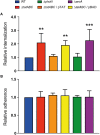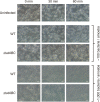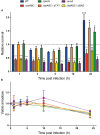Contribution of the Twin-Arginine Translocation System to the Intracellular Survival of Salmonella Typhimurium in Dictyostelium discoideum
- PMID: 30574134
- PMCID: PMC6291500
- DOI: 10.3389/fmicb.2018.03001
Contribution of the Twin-Arginine Translocation System to the Intracellular Survival of Salmonella Typhimurium in Dictyostelium discoideum
Abstract
The twin-arginine translocation (Tat) system is a specialized secretion pathway required for bacteria to export fully folded proteins through the cytoplasmic membrane. This system is crucial during Salmonella infection of animal hosts. In this study, we show that Salmonella enterica serovar Typhimurium (S. Typhimurium) requires the Tat system to survive and proliferate intracellularly in the social amoeba Dictyostelium discoideum. To achieve this, we developed a new infection assay to assess intracellular bacterial loads in amoeba by direct enumeration of colony forming units (CFU) at different times of infection. Using this assay we observed that a ΔtatABC mutant was internalized in higher numbers than the wild type, and was defective for intracellular survival in the amoeba at all times post infection evaluated. In addition, we assessed the effect of the ΔtatABC mutant in the social development of D. discoideum. In contrast to the wild-type strain, we observed that the mutant was unable to delay the social development of the amoeba at 2 days of co-incubation. This phenotype correlated with defects in intracellular proliferation presented by the ΔtatABC mutant in D. discoideum after 24 h of infection. All phenotypes described for the mutant were reverted by the presence of a plasmid carrying tatABC genes, indicating that abrogation of Tat system attenuates S. Typhimurium in this model organism. Overall, our results indicate that the Tat system is crucial for S. Typhimurium to survive and proliferate intracellularly in D. discoideum and for virulence in this host. To the best of our knowledge, this is the first report on the relevance of the Tat system in the interaction of any bacterial pathogen with the social amoeba D. discoideum.
Keywords: Dictyostelium; Salmonella; Tat system; infection; intracellular survival; social development; virulence.
Figures




Similar articles
-
Inorganic Polyphosphate Is Essential for Salmonella Typhimurium Virulence and Survival in Dictyostelium discoideum.Front Cell Infect Microbiol. 2018 Jan 30;8:8. doi: 10.3389/fcimb.2018.00008. eCollection 2018. Front Cell Infect Microbiol. 2018. PMID: 29441327 Free PMC article.
-
Relevant Genes Linked to Virulence Are Required for Salmonella Typhimurium to Survive Intracellularly in the Social Amoeba Dictyostelium discoideum.Front Microbiol. 2016 Aug 23;7:1305. doi: 10.3389/fmicb.2016.01305. eCollection 2016. Front Microbiol. 2016. PMID: 27602025 Free PMC article.
-
SopB- and SifA-dependent shaping of the Salmonella-containing vacuole proteome in the social amoeba Dictyostelium discoideum.Cell Microbiol. 2021 Jan;23(1):e13263. doi: 10.1111/cmi.13263. Epub 2020 Oct 13. Cell Microbiol. 2021. PMID: 32945061
-
[Dictyostelium discoideum: a model for the study of bacterial virulence].Can J Microbiol. 2011 Sep;57(9):699-707. doi: 10.1139/w11-072. Can J Microbiol. 2011. PMID: 21877947 Review. French.
-
Pathogen-host interactions in Dictyostelium, Legionella, Mycobacterium and other pathogens.Semin Cell Dev Biol. 2011 Feb;22(1):70-6. doi: 10.1016/j.semcdb.2010.11.003. Epub 2010 Nov 23. Semin Cell Dev Biol. 2011. PMID: 21109012 Review.
Cited by
-
The Tat system and its dependent cell division proteins are critical for virulence of extra-intestinal pathogenic Escherichia coli.Virulence. 2020 Dec;11(1):1279-1292. doi: 10.1080/21505594.2020.1817709. Virulence. 2020. PMID: 32962530 Free PMC article.
-
Animal Models of Type III Secretion System-Mediated Pathogenesis.Pathogens. 2019 Nov 22;8(4):257. doi: 10.3390/pathogens8040257. Pathogens. 2019. PMID: 31766664 Free PMC article. Review.
-
The Rcs System Contributes to the Motility Defects of the Twin-Arginine Translocation System Mutant of Extraintestinal Pathogenic Escherichia coli.J Bacteriol. 2022 Apr 19;204(4):e0061221. doi: 10.1128/jb.00612-21. Epub 2022 Mar 21. J Bacteriol. 2022. PMID: 35311558 Free PMC article.
-
The biogenesis of β-lactamase enzymes.Microbiology (Reading). 2022 Aug;168(8):001217. doi: 10.1099/mic.0.001217. Microbiology (Reading). 2022. PMID: 35943884 Free PMC article. Review.
-
Making a chink in their armor: Current and next-generation antimicrobial strategies against the bacterial cell envelope.Adv Microb Physiol. 2023;83:221-307. doi: 10.1016/bs.ampbs.2023.05.003. Epub 2023 Jun 27. Adv Microb Physiol. 2023. PMID: 37507160 Free PMC article.
References
-
- Abd H., Saeed A., Weintraub A., Nair G. B., Sandström G. (2007). Vibrio cholerae O1 strains are facultative intracellular bacteria, able to survive and multiply symbiotically inside the aquatic free-living amoeba Acanthamoeba castellanii. FEMS Microbiol. Ecol. 60 33–39. 10.1111/j.1574-6941.2006.00254.x - DOI - PubMed
-
- Bravo-Toncio C., Álvarez J. A., Campos F., Ortiz-Severín J., Varas M., Cabrera R., et al. (2016). Dictyostelium discoideum as a surrogate host-microbe model for antivirulence screening in Pseudomonas aeruginosa PAO1. Int. J. Antimicrob. Agents 47 403–409. 10.1016/j.ijantimicag.2016.02.005 - DOI - PubMed
LinkOut - more resources
Full Text Sources

